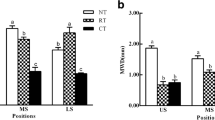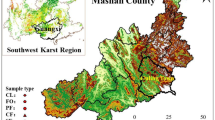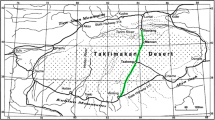Abstract
Although the West African inland valleys are characteristically wet all-year-round, their hydrological conditions are known to be site-specific and may differ markedly between the rainy and the dry seasons. Information on their physical properties would be useful for proper water management under the sawah rice culture and for planning dry season cropping. Representative inland valleys at four locations (Gadza, Nasarafu, Shaba-Maliki and Ejeti) around Bida in the Guinea savanna zone of Nigeria were selected for the study. Apart from Ejeti where the soil is clay loam, the predominant texture is sandy loam. The total and classified water-stable aggregates (WSA) were lowest at Ejeti, followed by Nasarafu. On the average, over 82% of the WSA were below 1.0 mm. Variations among the locations progressively decreased from the largest to the smallest aggregate-size class. Aggregate stability, as evaluated by both sand-corrected WSA and the mean weight diameter (MWD), followed similar trend as the WSA. Values were generally low for soil organic matter (SOM) (0.8–2.2%), but moderate for bulk density (0.98–1.55 Mg m−3) and total porosity (40.6–62.6%). Overall, Ejeti maintained the most favourable values of these three parameters, followed by Shaba-Maliki, Nasarafu and Gadza in the order listed. Micropores constituted over 87% of the soils’ pore system. Saturated hydraulic conductivities were, however, highly variable; indicating lowest rates at Ejeti. Clay fraction correlated positively with the unstable (<0.25 mm) aggregates and porosity parameters, but negatively with other structural indices. The SOM correlated negatively and positively with MWD and total porosity, respectively. Soil–water management implications of these results are discussed.
Similar content being viewed by others
References
Abe SS, Oyediran GO, Yamamoto S, Masunaga T, Honna T, Wakatsuki T (2007) Soil development and fertility characteristics of inland valleys in the rain forest zone of Nigeria: physicochemical properties and morphological features. Soil Sci. Plant Nutr 53:141–149
Andriesse W (1998) Mapping and characterizing inland valley agro-ecosystems: the case of West Africa. In: Wetland characterization and classification for sustainable agricultural development. FAO Corporate Document Repository. Available online: http://www.fao.org/docrep/003/x6611e/x6611e03a.htm#1_MAP
Andriesse W, Fresco LO, Van Duivenbooden N, Windmeijer PN (1994) Multi-scale characterization of inland valley agroecosystems in West Africa. Neth J Agric Sci 42:159–179
Bajpai RK, Tripathi RP (2000) Evaluation of non-puddling under shallow water tables and alternative tillage methods on soil and crop parameters in a rice-wheat system in Uttar Pradesh. Soil Tillage Res 55:99–106
Bhagat RM, Sharma PK, Verma TS (1994) Tillage and residue management effects on soil physical properties and rice yields in north western Himalayan soils. Soil Tillage Res 29:323–334
Blake GR, Hartge KH (1986) Bulk density. In: Klute A (ed) Methods of soil analysis, part 1: physical and mineralogical properties (2nd ed). American Society of Agronomy Monograph No. 9. American Society of Agronomy, Madison, pp 363–382
Chen S, Liu C (2002) Analysis of water movement in paddy rice fields (I) experimental studies. J Hydrology 260:206–215
Essoka AN, Esu IE (2003) Physical properties of inland valley soils of central Cross River State, Nigeria. Global J Agric Sci 2(1):37–42
Flint LE, Flint AL (2002) Pore size distribution. In: Done JH, Topp GC (eds) Methods of soil analysis, part 4: physical and mineralogical properties. American Society of Agronomy Monograph No 9. American Society of Agronomy, Masdison, pp 246–253
Fu RHY, Kikuno H, Maruyama M (2010) Research on yam production, marketing and consumption of Nupe farmers of Bida region, Niger State, central Nigeria. Abstract of paper presented at the 2010 conference of Japanese Association for African Studies (JAAS), 29–30 May. Kinki University, Nara, Japan, p 46
Gee GW, Bauder JW (1986) Particle size analysis. In: Klute A (ed) Methods of soil analysis, part 1: physical and mineralogical properties. Agronomy Monograph No 9. American Society of Agronomy, Madison, pp 91–100
Greenland DJ, Datta SKD (1985) Constraints to rice production and wetland soils characteristics. In: Proceedings of workshop on wetland soils: characterization, classification and utilization. SMSS, USDA, Washington, pp 23–36
Igwe CA, Stahr K (2004) Water-stable aggregates of flooded inceptisols from south-eastern Nigeria in relation to mineralogy and chemical properties. Aust J Soil Res 42(2):171–179
Kemper WD, Rosenau RC (1986) Aggregate stability and size distribution. In: Klute A (ed) Methods of soil analysis, part 1: physical and mineralogical properties. Agronomy Monograph No 9. American society of Agronomy, Madison, pp 425–442
Kirchhof G, So HB (1996) Puddling intensity and its effect on soil physical properties and rice growth. In: Proceedings of the international symposium on maximizing sustainable rice yields through improved soil and environmental management, 11–17 Nov, 1996, Khon Kaen, Thailand, vol 2, pp 529–536
Klute A, Dirksen C (1986) Hydraulic conductivity and diffusivity: laboratory methods. In: Klute A (ed) Methods of soil analysis, part 1: physical and mineralogical properties. Agronomy Monograph No 9. American Society of Agronomy, Madison, pp 687–734
Kukal SS, Singh Y, Yadav S, Humphreys E, Kaur A, Thaman S (2008) Why grain yield of transplanted rice on permanent raised beds declines with time? Soil Tillage Res 99:261–267
Kyuma K (2001) Tropical soil science. Nagoya University Press, Japan, p 385
Lal R (1986) Effects of 6 years of continuous no-till or puddling systems on soil properties and rice (Oryza sativa) yield of a loamy soil. Soil Tillage Res 8:181–200
Liu C, Yu W, Chen W, Chen S (2005) Laboratory investigation of plough sole reformation in a simulated paddy field. J Irrig Drain Eng 131(5):466–473
Nelson DW, Sommers LE (1996) Total carbon, total organic carbon, and organic matter. In: Sparks DL (ed) Methods of soil analysis, part 3: chemical methods. Agronomy Monograph No 9. American Society of Agronomy, Madison, pp 961–1010
Nwite JC, Igwe CA, Wakatsuki T (2010) Evaluation of sawah rice management system in an inland valley in southeastern Nigeria II: changes in soil physical properties. J Water Resour Prot 2:609–618
Obi ME (1984) Physical properties of wetland soils. Paper presented at the 12th Annual Conference Soil Science Society of Nigeria, 14–19 Oct. Port Harcourt, Nigeria, pp 12–18
Ogban PI, Babalola O (2003) Soil characteristics and constraints to crop production in inland valley bottoms in southwestern Nigeria. Agric Water Manage 61:13–28
Olaleye AO, Ogunkunle AO, Singh BN, Akinbola GE, Obuh J (2009) Morphology, organic carbon and dissolved nutrients in groundwater table in two benchmark wetlands sites in Nigeria. Agric Conspec Sci 74(1):31–37
Onweremadu EU, Izuogu OP, Akamigbo FOR (2010) Aggregation and pedogenesis of seasonally inundated soils of a tropical watershed. Chiang Mai J Sci 37(1):74–84
Sharma PK, Bhagat RM (1993) Puddling and compaction effects on water permeability of texturally different soils. J Indian Soc Soil Sci 41:1–6
Smaling EMA, Kiestra E, Andriesse W (1985) Detailed soil survey and quantitative land evaluation of the Echin-Woye and the Kunko Benchmark Sites, Bida Area, Niger State, Nigeria. Wetland Utilization Research Project, Phase II, International Institute for Land Reclamation and Improvement (ILRI), Wageningen, The Netherlands
So HB, Cook GD (1993) The effect of slaking and dispersion on the hydraulic conductivity of clay soil. Catena Suppl 24:55–64
Windmeijer PN, Andriesse W (eds) (1993) Inland Valleys in West Africa. An agro-ecological characterization of rice-growing environments. Publication 52, Institute for Land Reclamation and Improvement (ILRI), Wageningen, The Netherlands
Acknowledgments
This work was supported by the New Sawah Project (Nigeria) of the Kinki University, Japan, with the last author (T Wakatsuki) as the Project Leader. We appreciate the co-operation of Dr E. D. Imolehin of the NCRI, under whose co-ordinatorship of the Project the study was executed.
Author information
Authors and Affiliations
Corresponding author
Rights and permissions
About this article
Cite this article
Obalum, S.E., Nwite, J.C., Oppong, J. et al. Comparative topsoil characterization of sawah rice fields in selected inland valleys around Bida, north-central Nigeria: textural, structural and hydrophysical properties. Paddy Water Environ 9, 291–299 (2011). https://doi.org/10.1007/s10333-010-0233-3
Received:
Revised:
Accepted:
Published:
Issue Date:
DOI: https://doi.org/10.1007/s10333-010-0233-3




